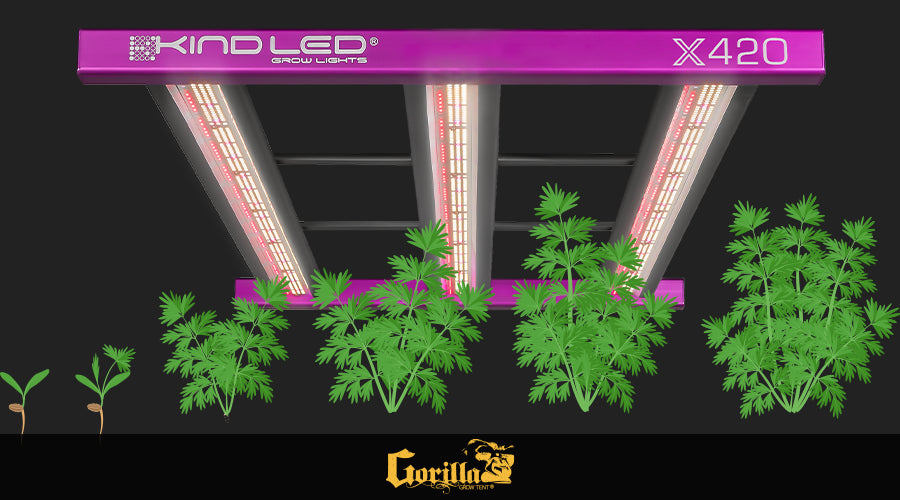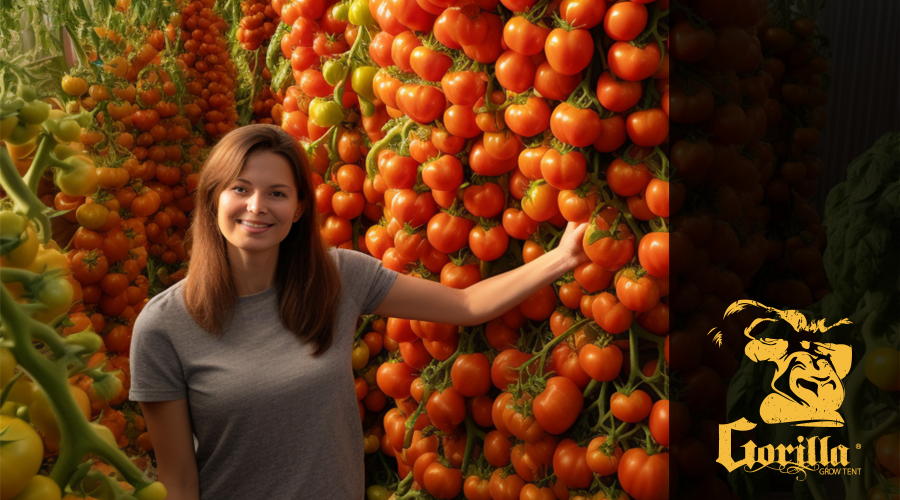
LED Grow Light for Plants - Perfect for All Growth Stages
Understanding the Power of LED Grow Lights for Plants
The world of horticulture is undergoing a revolution thanks to the advent of LED grow lights.
In the realm of indoor gardening, where the sun's rays may not always reach, LED grow lights emerge as beacons of hope, illuminating the path to flourishing plant life.
Whether you're nurturing a collection of houseplants, cultivating your own herb garden, or embarking on the exciting journey of cannabis cultivation, LED grow lights hold the key to unlocking a thriving indoor oasis.

Why LED Grow Lights? Unveiling the Advantages of LED Grow Lights
LED grow lights offer a myriad of benefits that set them apart from traditional lighting methods, making them the preferred choice for indoor cultivators. Their energy efficiency, long lifespan, and customizable light spectrum elevate them to the pinnacle of indoor gardening technology.
LED grow lights are renowned for their exceptional energy efficiency, converting up to 90% of their input energy into light, compared to only 20-30% for traditional fluorescent or incandescent lights. They consume less electricity while emitting a targeted spectrum of light ideal for plant growth.
This efficiency translates into significant savings on electricity bills, making LED grow lights a more cost-effective solution in the long run.
LED lights can be tailored to emit specific wavelengths of light that cater to different growth stages of plants. You can adjust the light spectrum to mimic natural sunlight, promoting optimal photosynthesis and better growth.
LED grow lights boast an impressive lifespan of up to 50,000 hours, far exceeding the lifespan of traditional lighting options. This longevity eliminates the need for frequent replacements, reducing maintenance costs and minimizing downtime for your indoor garden.
LEDs produce less heat compared to other lighting options. This is beneficial in indoor settings where temperature control is crucial for plant health. With less heat, you can place the lights closer to the plants without risking damage.
LEDs have instant on/off capabilities and can be easily dimmed without affecting their lifespan. This feature allows growers to simulate natural light cycles more accurately and provides better control over the growth environment.
LED grow lights come in various shapes and sizes, making them adaptable to different setups, from small indoor gardens to large commercial operations. They're also more compact and can be arranged in specific configurations to suit the needs of different plant types.
LED lights are generally more environmentally friendly. They contain no toxic elements (unlike some other types of bulbs) and are recyclable. Additionally, their energy efficiency contributes to reduced electricity consumption and lower carbon emissions.
Harnessing the Power of Light: How LED Grow Lights Work
These innovative devices have transformed indoor gardening, providing growers with a powerful tool to cultivate vibrant, healthy plants, regardless of the season or climate. But how do these remarkable lights work their magic? Let's delve into the science behind LED grow lights and uncover the secrets that make them so effective.
The Science of Photosynthesis
Plants, the lifeblood of our planet, rely on a process called photosynthesis to convert sunlight into energy. This intricate process involves chlorophyll, a pigment that absorbs light energy, primarily from the red and blue wavelengths of the electromagnetic spectrum. The absorbed energy is then used to convert carbon dioxide and water into glucose, the primary fuel for plant growth.
Mimicking Sunlight with LEDs
LED grow lights harness the power of semiconductor diodes to emit light in specific wavelengths that are essential for photosynthesis. These diodes, when energized, release electrons that recombine with holes, creating a surge of energy that is released in the form of photons – tiny packets of light. By carefully selecting the composition of the semiconductor material, scientists can tailor the wavelength of light emitted by the LED to match the specific needs of different plants.
Red Light for Flowering and Fruiting
Red light, with wavelengths between 600 and 700 nanometers, plays a crucial role in stimulating flowering and fruit production. This warm light triggers the production of phytochrome, a pigment that influences the plant's reproductive cycle. When exposed to red light, plants begin to prepare for flowering, producing the vibrant blooms and fruits that we enjoy.
Blue Light for Vegetative Growth
Blue light, with wavelengths between 400 and 500 nanometers, is essential for promoting vegetative growth, encouraging the development of strong stems, leaves, and roots. This cool light triggers the production of cryptochrome, a pigment that regulates growth patterns. By providing an adequate amount of blue light, growers can ensure that their plants develop a sturdy foundation for optimal growth.
Choosing the Right LED Grow Light
Choosing the right LED grow light involves considering several factors to ensure it suits your specific needs and the requirements of your plants.
Here's a guide to help you select the appropriate LED grow light:
Light Spectrum: Different plants have varying light requirements at different growth stages. Look for lights that offer a customizable spectrum or ones specifically designed for the growth phase (vegetative or flowering) of your plants. Consider lights that provide both blue and red wavelengths, as they are crucial for different growth stages.
Light Intensity and Coverage: Check the light's wattage and the coverage area it can effectively illuminate. Ensure it matches the size of your growing space and the number of plants you have. Pay attention to the light's PAR (Photosynthetically Active Radiation) output, which measures the light intensity usable by plants.
Energy Efficiency: Opt for energy-efficient LEDs that consume less electricity while delivering the required light intensity. Look for lights with high efficacy ratings (measured in micromoles per joule - µmol/J) as they indicate how efficiently the light converts electricity into usable light for plants.
Durability and Lifespan: Consider the build quality and the expected lifespan of the LED grow light. Lights with good heat management systems and quality components tend to last longer. Check reviews or product specifications for information on lifespan and reliability.
Adjustability and Control: Some LED grow lights offer adjustable intensity or spectrums, allowing you to customize the light output based on your plants' needs. This flexibility can be beneficial for different growth stages or varying plant types.
Brand Reputation and Reviews: Research different brands and read reviews from other growers to gauge the performance and reliability of the LED grow lights. A reputable brand with positive feedback is more likely to offer a quality product.
Budget: LED grow lights come in various price ranges. Determine your budget while considering the features and quality that align with your requirements. Remember that higher-quality lights may have a higher upfront cost but can save money in the long run due to their efficiency and longevity.
Warranty and Support: Check the warranty and available customer support offered by the manufacturer. A good warranty indicates the manufacturer's confidence in their product and provides assurance in case of any issues.
LED Grow Lights: Lighting the Path to Indoor Gardening Success
LED grow lights have revolutionized indoor gardening, providing growers with an unparalleled level of control over the light environment of their plants. Their energy efficiency, long lifespan, and customizable light spectrum make them the ideal choice for cultivating healthy, thriving plants in any indoor setting.
As you embark on your journey of cultivating a flourishing indoor garden, remember that LED grow lights are your allies in this endeavor. By harnessing the power of light, you can nurture your plants, watch them thrive, and witness the fruits of your labor – a vibrant oasis of greenery right in your home.


